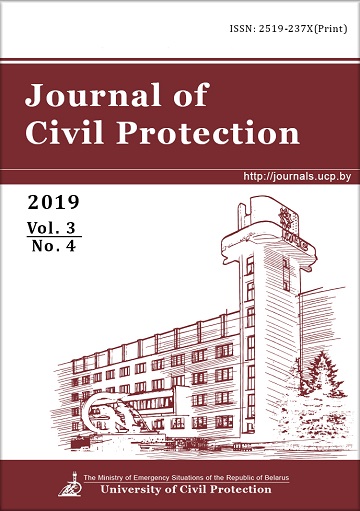Fire visibility calculation method
DOI:
https://doi.org/10.33408/2519-237X.2019.3-4.412Keywords:
modeling, visibility, smoke generating ability, specific smoke output, visibility factor, specific extinction index, illumination, reflection coefficientAbstract
Purpose. The development of a methodology for calculating visibility at a fire, based on a mathematical model of the propagation of optical radiation through a scattering medium and supplemented by taking into account modeling parameters.
Methods. Simulation of smoke dynamics in a fire.
Findings. A method for calculating the visibility of a fire based on a mathematical model of the propagation of optical radiation through a scattering medium and supplemented by taking into account the color of the interior of the premises, comprehensive assessment of the smoke-generating ability of the fire load and its share of combustion is presented. A methodology for determining the values and application of parameters for modeling visibility at a fire is described.
Application field of research. The results can be applied in fire modeling.
References
Zotov Yu.S. Protsess zadymleniya pomeshcheniy pri pozhare i razrabotka metoda neobkhodimogo vremeni evakuatsii lyudey [The process of smoke in a fire and the development of a method for the necessary time for evacuation of people]: PhD tech. sci. diss.: 05.26.01. Moscow, 1989. 273 p. (rus)
Serebrennikov D.S., Litvincev K.Yu. Obzor modeley rasprostraneniya dyma I opredeleniya dalynosti vidimisti [Models of smoke propagation and determination of range of visibility]. Technology of technosphere safety, 2011. № 1 (35), availiable at: http://agps-2006.narod.ru/ttb/2011-1/06-01-11.ttb.pdf (accessed: November, 11, 2019).
McGrattan K., Miles S. Modeling Enclose Fires Using Computational Fluid Dynamics (CFD). SFPE Handbook of Fire Protection Engineering. Ed. by P.J. DiNenno [et al.]. 4th ed. Quincy, Massachusetts: National Fire Protection Association, 2008. Ch. 3. Рp. 3229–3247.
Surikov A.V., Leshenyuk N.S. Determination of simulation parameters values and output data interpretation in FDS during calculating visibility in smoke conditions. Journal of Civil Protection, 2018. Vol. 2, No. 3. Pp. 308–319. (rus) DOI: 10.33408/2519-237X.2018.2-3.308.
Leonovich A.A. [et al.]. Additivnost' koeffitsienta dymoobrazovaniya kompozitsionnykh materialov [Additivity of the coefficient of smoke formation of composite materials]. Bezopasnost' lyudey pri pozharakh: collection of proceedings. Moscow, 1984. Pp. 147–160. (rus)
Surikov A.V., Leshenyuk N.S. Modeling of visibility in a room under fire conditions with application of the FDS software complex. Journal of Civil Protection, 2018. Vol. 2, No. 2. Pp. 147–160. (rus) DOI: 10.33408/2519-237X.2018.2-2.147.
Mulholland G.W., Croarkin C. Specific extinction coefficient of flame generated smoke. Fire and Materials, 2000. Vol. 24, No. 5. Pp. 227–230. DOI: 10.1002/1099-1018(200009/10)24:5<227::AID-FAM742>3.0.CO;2-9.
SFPE Handbook of Fire Protection Engineering. Ed. by P.J. DiNenno [et al.]. 4th ed. Quincy, Massachusetts: National Fire Protection Association, 2008. 3396 р.
Published
How to Cite
License
Copyright (c) 2019 Surikov A.V., Leshenyuk N.S.
CC «Attribution-NonCommercial» («Атрибуция — Некоммерческое использование») 4.0




















